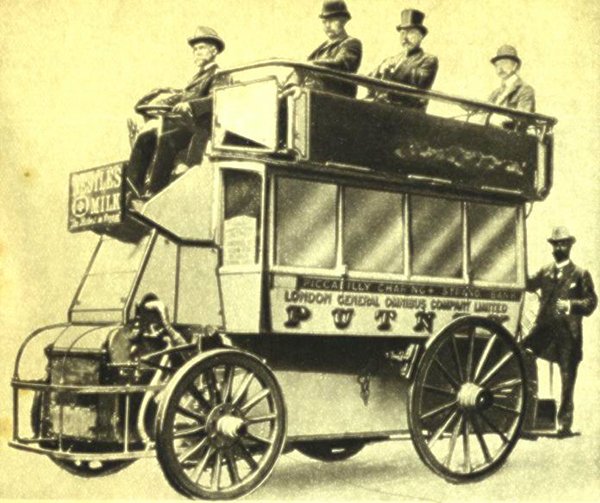
The Horseless Horse Bus Mystery
The Horseless Horse Bus Mystery

I found this picture in a house clearance store some time ago and it has puzzled me ever since. Although I was at one time a member of The Omnibus Society, I have never seen any reference to the LGOC ever experimenting with the conversion of horse buses to petrol power. Looking back to the start of the twentieth century it must have been obvious to the management of the company that mechanical means of traction were just around the corner. With this in mind it would also have been clear that many hundreds of horse pulled buses would very quickly be made redundant. A horse bus without a horse is about as useful as a chocolate teapot, not to mention the loss of a huge capital investment that would have been made over the years. Breaking them up would only produce a pile of firewood and a small amount of metal, so experimenting with some form of ‘clip on’ power unit would be the natural next step.
Close examination of the picture reveals several interesting points. The first being that there does not seem to be any direct mechanical connection between the steering column and the road wheels, although this may be hidden within some form of cover around the front end. The second being that there is no weather protection for the driver. Although this was the normal state of affairs during the Victorian era, the increase in speed and the advent of wind chill seemed hardly to be understood at a time when drivers of all vehicles were considered as mere extensions of their machines. Thirdly, despite the potential increase in performance, the vehicle is still only equipped with smooth iron tyres with wooden brake blocks acting directly upon these. One shudders to think of the handling characteristics of this machine with a full load on a steep cobbled incline in mid winter.
There are no road springs or any obvious means of power transmission to the rear wheels, the accepted method of the time being side chains. Close examination of the rear hubs revealing the usual open ends associated with the free wheeling type used on all horse drawn carts. The front hubs, however, appear solid with a projecting stub suggesting front wheel drive.
There also seems, although it is not clear in the picture, that something large and round is just behind the front wheel, an electric motor perhaps? Although the engine looks as if it might be a petrol driven unit – there are various pipes and a radiator at the front – a petrol electric drive transmission system would make the teaching of horse bus drivers much easier than them having to grapple with primitive gearboxes. As the underside of the body is boxed in, this could be the housing for the batteries.
It is unlikely that at this time the LGOC had the necessary mechanical expertise to design and build such a machine and is perhaps a ‘one off’ built by one of the many entrepreneurs jumping on the internal combustion band wagon.
Was this machine ever built or is it just an illustration of what might be achieved as a ‘clip on’ interim answer to allow a few more miles to be squeezed out of their old vehicle stock? The crew manning this machine do not look like the typical men who would be out in all weathers for fifteen hours a day earning a few shillings a week. They look more like directors of the company posing just for the picture in their smart Homburg hats and expensive suits.
John Barringer
02/2011
Comments regarding the above are more than welcome please get in touch via the 'Contact Page' or by email at obp-admin@nwframpton.com
If you have a bus related article that you would like to appear on this site please get in touch via the 'Contact Page' or by email at obp-admin@nwframpton.com
All rights to the design and layout of this website are reserved
Old Bus Photos from Saturday 25th April 2009 to Wednesday 3rd January 2024